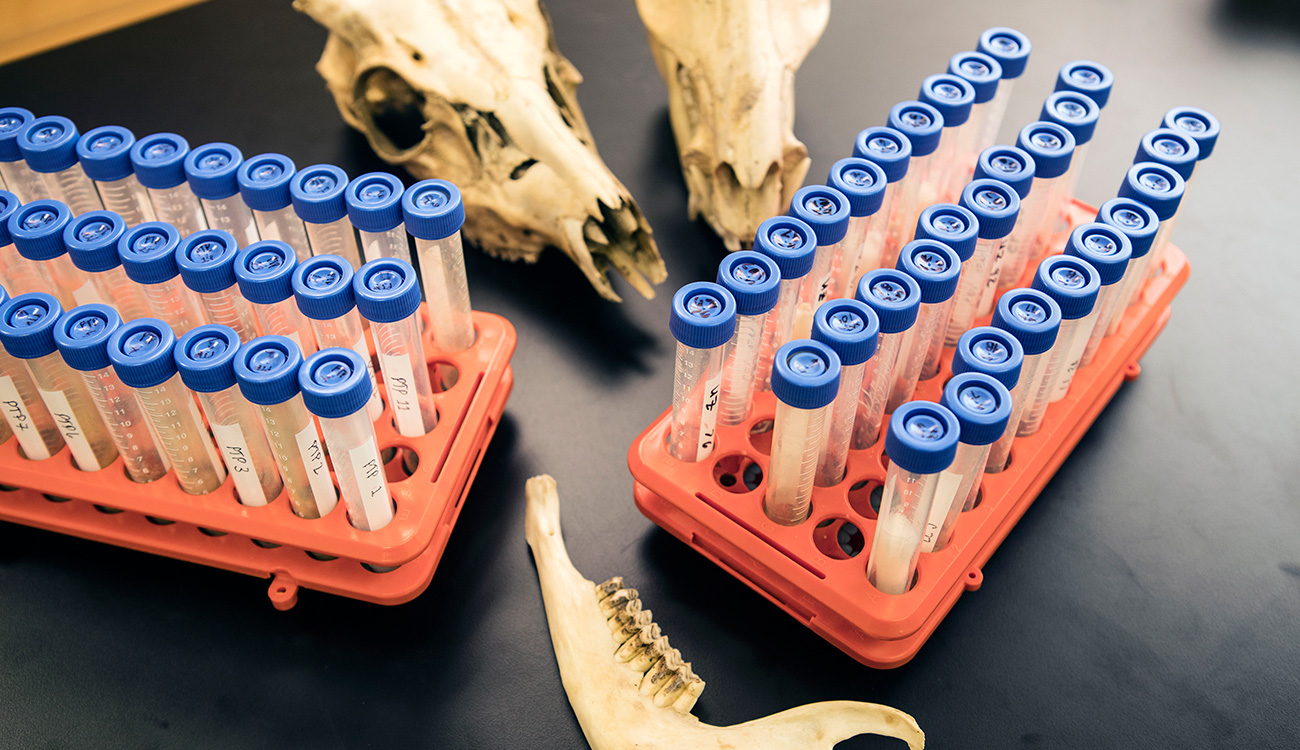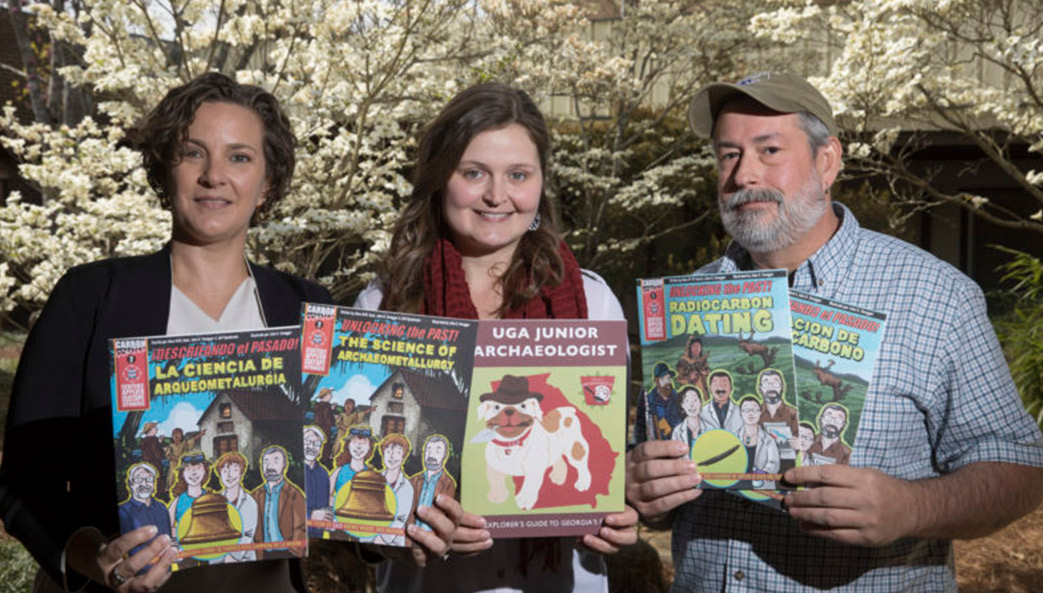In March 2017, Suzanne Pilaar Birch turned to Twitter for help. The archaeologist and UGA assistant professor was considering an invitation to go on a dig in Cyprus, an offer that seemed irresistible—except that she would be six months pregnant. She wanted some reassurance that she wasn’t crazy, so she tweeted: “Anyone else #pregnantinthefield? How far along were you, how far did you travel, how long was fieldwork? (Maybe even, what did you wear?)”
Pilaar Birch (who tweets as @suzie_birch) had a built-in audience through TrowelBlazers, an online community she co-founded that celebrates women in archaeology, geology and paleontology. The response was overwhelming, with women posting photos and details about their gestational fieldwork such as “living in a van … and digging holes across Iceland” at five months, and “7+ months along while sampling in Death Valley.” The photos were taken in locations including Argentina, China, Belize, Kenya, Oman, Kazakhstan and Australia, and some dated as far back as the ’70s.
With those examples in mind, Pilaar Birch made her decision, tweeting: “On my way to Cyprus for two weeks of fieldwork! Bring it on! #pregnantinthefield.”
“It was nice to have the reassurance that for years women have been doing fieldwork while pregnant, even if it was not being talked about,” she says.
In December, #pregnantinthefield was named one of the top 10 hashtags for 2017 by LiveScience.com, a science and technology news site. Pilaar Birch hopes it will help women who find themselves debating the questions she faced last year. She also sees it as part of a larger conversation about what it’s like to be a woman in science, especially in light of the #MeToo movement.
“We need to talk about things that affect women if we want women to be more equal,” she says.

TrowelBlazers was founded by four disgruntled people on Twitter.
In 2013, Pilaar Birch had finished her Ph.D. at the University of Cambridge and moved back to the United States (she grew up in New Jersey) for a post-doctoral position at Brown University. She was working on a project that involved using Twitter, and that’s where she encountered three other women who shared her frustration with how TV shows treated scientists.
“We were complaining because all the documentaries are always led by guys and also about men,” she says. “If a man invented something, then he gets named, but if a woman did it, she’s not mentioned.”
Along with Victoria Herridge, Brenna Hassett and Rebecca Wragg Sykes, Pilaar Birch created TrowelBlazers (trowelblazers.com) to pay tribute to the trowel-wielding women who came before them. The four researched, wrote and posted biographies of their predecessors, discovering more women—and more connections—than anticipated.
“We didn’t expect that anyone was going to care,” Pilaar Birch says. “But even during the first month, we could tell that it was resonating with people.”
The subject of their first post, Dorothy Garrod, was a pioneer of Paleolithic archaeology and the first woman to hold a professorship at the University of Cambridge in 1939. Garrod also led excavations featuring international teams of women, serving as a hub in a growing network.
“There were women mentoring other women,” Pilaar Birch says. “It wasn’t just every woman for herself.”
Another subject, Yusra, was a Palestinian woman who was part of Garrod’s excavation team. In 1932, Yusra discovered the skull of a female Neanderthal—the specimen Tabun 1, estimated to be between 122,000 and 50,000 years old—on Mount Carmel, in what is now northern Israel. Using their documentation, Pilaar Birch and her colleagues persuaded the Smithsonian Institution, owner of the fossil, to alter their records to reflect Yusra’s find.
The TrowelBlazers also got involved with issues on social media. When 8-year-old Sophie Trow was told by a shoe company that the dinosaur shoes she wanted “weren’t for girls,” they started #InMyShoes and posted a photo of Hassett’s black Converse with a pterosaur perched on top. Other women joined in, posting images of the shoes they used for their careers in fields including engineering, volcanology and industrial design.
Their efforts garnered coverage by CNN and The Guardian, and their social media presence continued to grow. The group now has 5,500-plus Twitter followers; 5,000-plus Facebook likes; 4,000-plus Tumblr followers; and growing communities on Pinterest and Instagram.
Their success has led to other opportunities as well. Herridge has made TV programs for Channel 4 in the United Kingdom, including “Woolly Mammoth: The Autopsy” and “Britain at Low Tide.” And Hassett spoke at the March for Science London in April 2017.
“When we started, we had no idea that so much was going to come our way,” Pilaar Birch says.
The Fossil Hunter Lottie doll was a collaboration between the TrowelBlazers and Arklu, a toy company based in Ireland. Lottie is ready for action—she comes with fossil hunting tools including a magnifying glass, trowel and geology hammer as well as four ammonite fossils. (Photo by Amy Ware)
While the four women were building TrowelBlazers, they were also moving forward with their individual careers. Pilaar Birch joined the UGA faculty in 2014 with a joint appointment in anthropology and geography, both in the Franklin College of Arts and Sciences. Her research focuses on human adaptation and resilience to climate change and natural resource unpredictability in the period spanning the end of the last ice age to the arrival of farming. She combines archaeology and biogeochemistry to investigate changes in diet, mobility and settlement systems. She also specializes in zooarchaeology—the study of animal bones.
“It’s like a giant puzzle,” she says. “You’re trying to figure out what species they belong to, what part of the body, are there cut marks, what kind of other damage is there?”
Her other primary methodology is stable isotope analysis, performed at the Quaternary Isotope Paleoecology Laboratory, which she directs. Based on the principle that “you are what you eat,” this method measures the ratios of isotopes like carbon, oxygen and nitrogen that are left behind in materials like bones, teeth and shell, allowing her to trace the flow of nutrients through an individual. From there, she can extrapolate to larger questions about society and the ancient environment.
“It’s tricky to go between the individual and the societal scales, but that’s what I really like about what I do,” she says. “I can have these big questions and break them down and answer very specific questions with these methods.”
Pilaar Birch also collaborates with the other TrowelBlazers, though they specialize in different areas.
Victoria Herridge is a paleobiologist who focuses on the evolution of dwarf elephants. In January 2015, Pilaar Birch joined Herridge at a cave in Malta and took samples for a project they’re still working on.
Pilaar Birch and Brenna Hassett, a bioarchaeologist, have received a grant of nearly $1 million from the Arts and Humanities Research Council in the U.K. for a project at a Bronze Age site in Turkey, where Hassett will examine human bones and teeth while Pilaar Birch conducts stable isotope analysis of the remains.
Rebecca Wragg Sykes is a Paleolithic archaeologist who’s fascinated with Neanderthals and their stone tools. She is collaborating with Pilaar Birch on a project that explores hunter-gatherer mobility, both Neanderthal and modern human.
“What do the stones say? What do the bones say?” Pilaar Birch summarizes. “How can we look at human mobility and migration through time, from multiple subspecialties within archaeology, and bring those together to form a more cohesive idea?”
The four founders of TrowelBlazers have become close friends during the past five years, a period that brought big changes in each of their lives.
“We all started out at the same time as postdocs, but now we’ve moved forward and three of us have children,” Pilaar Birch says. “We talk about everything—personal, professional, anything. When one of us feels like we can’t handle something, the others provide encouragement.”
The four founders of TrowelBlazers are constantly in touch via WhatsApp, but they’re separated by geography, with Pilaar Birch in the U.S., Herridge in London, Hassett in Greece and Wragg Sykes in Wales. There’s only been one occasion when all four were in the same place at the same time.
That was February 2017, when they met in London for the opening of Raising Horizons, their project in collaboration with photographer Leonora Saunders. Fourteen contemporary women working in archaeology, geology and paleontology posed as their historic counterparts, each representing a moment in time. The exhibit is touring in the U.K., and Pilaar Birch hopes to bring it to the U.S.
Once a year, the four women discuss their vision for TrowelBlazers and how they want to move forward, something they refer to as their “plan for world domination.”
That plan includes a book deal for a collection of biographies of trowel-blazing women with an analysis of the social networks that connected them. Pilaar Birch expects that it will emphasize something she has experienced personally with her co-creators that’s also one of the fundamental truths underlying the TrowelBlazers project.
“Women have been supporting each other for a long time,” she says.






